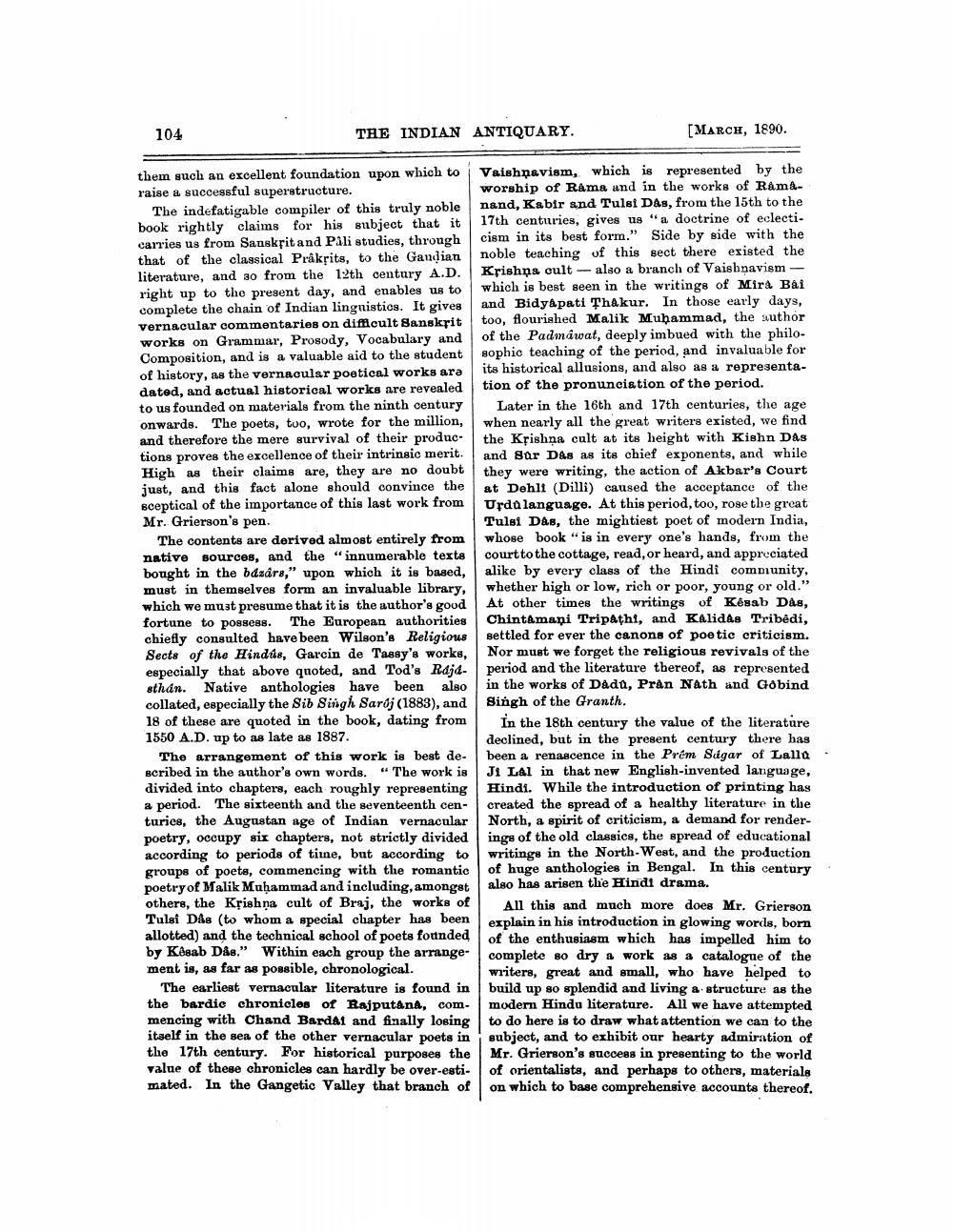________________
104
THE INDIAN ANTIQUARY.
[MARCH, 1890.
them such an excellent foundation upon which to | Vaishnavism, which is represented by the raise a successful superstructure.
worship of Rama and in the works of RamaThe indefatigable compiler of this truly noble nand, Kabir and Tulsi Das, from the 15th to the book rightly claims for his subject that it 17th centuries, gives us "a doctrine of eclecti. carries us from Sanskrit and Pali studies, through cism in its best form." Side by side with the that of the classical Prakrits, to the Gandian noble teaching of this sect there existed the literature, and so from the 12th century A.D. Krishna cult - also a branch of Vaishnavism - right up to the present day, and enables us to which is best seen in the writings of Mira Bai complete the chain of Indian linguistics. It gives and Bidy&pati Thakur. In those early days, vernacular commentaries on difficult Sanskrit too, flourished Malik Muhammad, the uuthor works on Grammar, Prosody, Vocabulary and of the Padmawat, deeply imbued with the philoComposition, and is a valuable aid to the student sophic teaching of the period, and invaluable for of history, as the vernacular poetical works ara its historical allusions, and also as a representadated, and actual historical works are revealed tion of the pronunciation of the period. to us founded on materials from the ninth century Later in the 16th and 17th centuries, the age onwards. The poets, too, wrote for the million, when nearly all the great writers existed, we find and therefore the mere survival of their produc the Krishna cult at its height with Kishn Das tions proves the excellence of their intrinsic merit. and Sur Das as its chief exponents, and while High as their claims are, they are no doubt they were writing, the action of Akbar's Court just, and this fact alone should convince the at Dehlt (Dilli) caused the acceptance of the sceptical of the importance of this last work from Urdu language. At this period, too, rose the great Mr. Grierson's pen.
Tulsi Dås, the mightiest poet of modern India, The contents are derived almost entirely from whose book " is in every one's hands, from the native sources, and the "innumerable texts court to the cottage, read, or heard, and appreciated bought in the bdaárs," upon which it is based, alike by every class of the Hindi community, must in themselves form an invaluable library, whether high or low, rich or poor, young or old." which we must presume that it is the author's good At other times the writings of Kesab Das, fortune to possess. The European authorities Chintamaņi Tripathi, and Kalidas Tribêdi, chiefly consulted have been Wilson's Religious settled for ever the canons of poetic criticism. Sects of the Hindus, Garcin de Tassy's works, Nor must we forget the religious revivals of the especially that above quoted, and Tod's Raid period and the literature thereof, as represented sthan. Native anthologies have been also in the works of Dada, Pran Nath and Gobind collated, especially the Sib Singh Saroj (1883), and Singh of the Granth. 18 of these are quoted in the book, dating from In the 18th century the value of the literature 1550 A.D. up to as late as 1887.
declined, but in the present century there has The arrangement of this work is best de- been a renascence in the Prem Sugar of Lalla scribed in the author's own words. "The work is Ji Lal in that new English-invented language, divided into chapters, each roughly representing Hindi. While the introduction of printing has a period. The sixteenth and the seventeenth cen- created the spread of a healthy literature in the turies, the Augustan age of Indian vernacular North, a spirit of criticism, a demand for renderpoetry, occupy six chapters, not strictly divided ings of the old classics, the spread of educational according to periods of time, but according to writings in the North-West, and the production groups of poets, commencing with the romantic of huge anthologies in Bengal. In this century poetry of Malik Muhammad and including, amongst also has arisen the Hindi drama. others, the Kțishna cult of Braj, the works of All this and much more does Mr. Grierson Tulsi Das (to whom a special chapter has been explain in his introduction in glowing words, born allotted) and the technical school of poets founded of the enthusiasm which has impelled him to by Kesab Dås." Within each group the arrange- complete so dry a work as a catalogue of the ment is, as far as possible, chronological.
writers, great and small, who have helped to The earliest vernacular literature is found in build up so splendid and living a structure as the the bardic chronicles of Rajputana, com. modern Hindu literature. All we have attempted mencing with Chand Bardat and finally losing to do here is to draw what attention we can to the itself in the sea of the other vernacular poets in subject, and to exhibit our hearty admiration of the 17th century. For historical purposes the Mr. Grierson's success in presenting to the world value of these chronicles can hardly be over-esti- of orientalists, and perhaps to others, materials mated. In the Gangetic Valley that branch of on which to base comprehensive accounts thereof.




